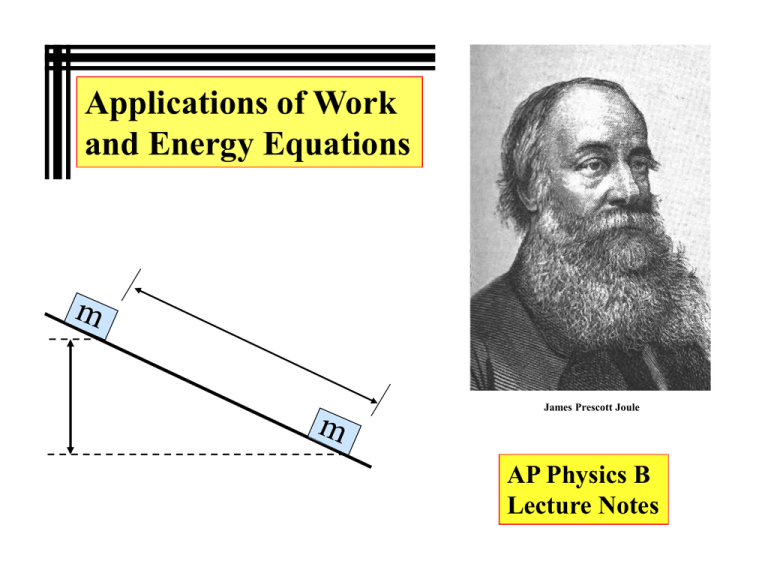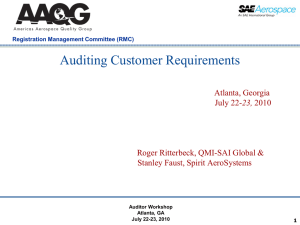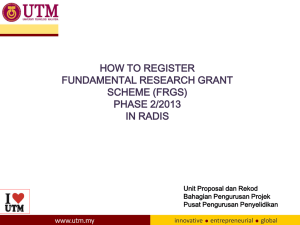Work = Fd cos(q)
advertisement

Applications of Work and Energy Equations James Prescott Joule AP Physics B Lecture Notes Problem #1 A student holds her physics textbook, which has a mass of 1.50 kg from the second floor which is 3.0 m from the ground. She then drops it. a) How much work is done on the book by the student in simply holding it? b) How much work will have been done by the force of gravity during the time the book falls 3.0 m? 1) A known mass held, then dropped; determine a) Wst and b) Wgr PHYSICS 3.0 m 2) Given: m = 1.50 kg, and h = 3.0 m; Find: Wst and Wgr 3) Work / gravity RMc Problem #1 4-5) a) Net work on the book by student: Since the book does not move, there is no displacement and therefore, no work done. Work = Fd cos(q) Wst = F(0) cos(q) = 0.0 J b) Net work on the book by force of gravity: While the book is falling, the Net force is equal to the weight (mg). PHYSICS -3.0 m Work = Fd cos(q) mg Wgr = (1.50kg)(-9.81m/s2)(-3.0m)cos(0) = +44 J RMc Problem #2 If a person pushes on the lawn mower with a constant force of 90.0 N at an angle of 40.0 to the horizontal: How much work does he do in pushing it a horizontal distance of 7.50 m? 1) A constant force at angle thru distance; determine Wh 90.0 N 2) Given: F = 90.0 N, and q = 40.0; d = 7.50 m Find: Wh 40.0 3) Work / horizontal RMc Problem #2 4-5) Net work on the mower by person: The force vector and the displacement vector must be parallel for work to be done. Work = Fd cos(q) 90.0 N 40.0 F cos(q) = Fh 7.50 m 40.0 Fh = (90.0N)(cos 40.0) Fh = 68.94 N Wh = (68.94N)(7.50m) = +517 J RMc Problem #3 A 0.75 kg block slides down a 20.0 inclined plane with a uniform velocity. The horizontal length of the incline is 1.20 m. a) How much work is done by the force of friction on the block as it slides the total length of the incline? b) What is the net work done on the block? y N Ff mg sin(q) mg cos(q) q x mg 1.20 m 1) Box slides at constant velocity against friction; determine Wf , and Wnet 2) Given: m = 0.75 kg, and q = 20.0;L = 1.20 m Find: Wf and Wnet q 3) Work / incline-friction RMc Problem #3 4-5) a) Net forces parallel to the motion: y Ff N mg sin(q) mg cos(q) x Only two forces do work because there are only two forces parallel to the motion. The force of kinetic friction Ff and the weight component down the incline mg sin(q). Work done by the frictional force: Ff = mN W = Ffd cos(q) = Ffd cos(180) = Ffd (-1) W = mNd(-1) Ff = mg sin (q) from uniform motion N = mg cos(q) from diagram m Ff N RMc Problem #3 N = mg cos(q) from diagram mg sinq m tanq N mg cosq Ff d q W = mNd(-1) Therefore: L d cosθ L from right triangle incline L W = -tan(q)mgcos(q)( ) cosθ W = -tan(20.0)mgL = -(.3639)(0.75kg)(9.81m/s2)(1.20m) W= -3.21 J RMc Problem #3 4-5) b) Net forces parallel to the motion: y Ff mg sin(q) Since the force of kinetic friction Ff is equal to weight component down the incline mg sin(q), the net force is equal to zero. x The Net work done: Wnet = Fnetd cos(q) Wnet = (0)d cos(q) Wnet = 0.0 J RMc Problem #3 A car of mass m is on an icy driveway inclined at an angle of 20.0. Determine the acceleration of the car (assume the incline is frictionless). N 1) Unknown mass down frictionless incline; determine acceleration. mg cos(q) y 2) Given: q = 20.0; Find: am Ff mg sin(q) 3) Newton’s 2nd Law / inclined frictionless x mg q RMc Work Done by a Constant Force Work = Fd cos(q) RMc Work Equation F q Fcos(q) d Work = Fd cos(q) RMc Units of Work System Unit of Work SI newton-meter Joule (J) cgs dyne-centimeter erg British foot-pound RMc Work-Kinetic Energy Theorem vf vi F m x The net work done on an object by a net force acting on it is equal to the change in kinetic energy of the object RMc Work-Kinetic Energy Theroem A net force acts on a moving object vi vf F Kinetic Energy m F a m x 2 2 v f2 v i2 2ax mv f mv i Fx 2 2 F 2 2 v f v i 2 x Work KEf - KEi m m v f2 - v i2 Fx 2 Work NET Δ Kinetic Energy RMc Work Done Against Friction Friction acts on moving object m Ff m d Ff μN Wf Ff d Wf mNd RMc The Force to Stretch a Spring F -kx Hooke’s Law RMc x F kx F F Work kx kx 2 2 0 x RMc Work Done by Gravity Object falls in a gravitational field m mg h m Wg = mgh RMc Work and Energy Equations Work done by force (F) = Fd cos( q) Kinetic energy = mv 2 2 Work done by gravity = mgh Work done by a spring = Work done against friction = kx 2 2 mNd RMc Gravity and Kinetic Energy Ball drooped from rest Find the final velocity of the ball: mv 2 2 mgh Wg KE h mv 2 mgh 2 v 2gh v RMc Spring and Kinetic Energy Work done by a spring Find the final velocity of the block: v k m m x kx 2 2 Ws KE kx 2 mv 2 2 2 mv 2 2 kx 2 v m RMc Spring and Friction Work done by friction k Find the displacement of the block: v=0 m m x kx 2 2 Ws Wf d=? mNd 2 kx mNd 2 2 mg kx 2 d 2mmg kx mmgd 2 RMc Kinetic Energy and the Incline Plane Find the final velocity of the block: vo = 0 d h q mv 2 mgd sinq 2 mv 2 2 mgh Wg KE V=? mv 2 mgh 2 h = d sin(q) v 2gd sinq RMc Gravitational Potential Energy Work Done due to Gravity PE mghf - mghi m PEi mgh PE 0 - mgh PE -mgh Wg mgh h Wg -PE m PEf 0 RMc Elastic Potential Energy kx 2 PE 2 kx 2 PE 0 2 k x k kx 2 Ws 2 PE 0 kx 2 PE 2 Ws - PE RMc Conservation of Mechanical Energy The mechanical energy (Emec) of a system is Emec K U When no external forces act on a system Emec 0 Emec K U 0 K U 0 KEf - KEi PEf - PEi 0 KEf PEf KEi PEi Conservation of Mechanical Energy RMc Potential and Kinetic Energy Conservation of Mechanical Energy U K U U U K U K K K Power Energy can be transferred from one form to another through the process of work. The rate at which work is done is called power Average power Pavg ΔE F vavg Δt RMc Work and Energy END





